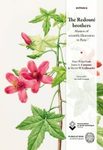By
Leon (NHBS Catalogue Editor)
20 Dec 2017
Written for Hardback

In 2012, Titan Books published
Dinosaur Art, showcasing the artwork of 10 famous palaeoartists. That book is still on my wishlist. Five years later they have followed this up with
Dinosaur Art 2. The title may not be terribly imaginative, but, by Jove, the artwork is! The child in me got all giddy at the chance to review this book.
After a foreword by Brian Switek, who raises the profile of this art genre and highlights its importance to science, and a really quite technical introduction by Robert Nicholls on his reconstruction of
Psittacosaurus, the meat of the book consists of ten chapters, each showcasing select work of well-known contemporary palaeoartists.
The artwork is fantastic and ranges from photorealistic digital artwork to more traditionally painted works, to pencil sketches and anatomical studies. To mix things up a bit, the chapter on the German sculptor Vitali Klatt shows photos of his resin models. There are colourful full-page and double-page spreads (even a few fold-out spreads), but also moody, subdued pieces. And it’s not all dinosaurs either; marine reptiles, pterosaurs and Cenozoic mammals are also featured. The pictures alone will keep you browsing for a long time.
What really makes this book captivating, however, are the interviews with each artist. They are given ample space to talk about their start as artists, their working methods, and current developments in palaeontology. This makes for incredibly interesting reading. All of these artists are knowledgeable, with Mark Witton and Velizar Simeonovski combining a career as artist and biologist or palaeontologist, and Jason Brougham being Senior Principal Preparator at the American Museum of Natural History. But even those who don’t have a professional background in the life sciences profess to doing an incredible amount of research before each piece, taking into account the latest findings when making their drawings, and collaborating closely with palaeontologists. In turn, many of their drawings are used in museum exhibitions or in scientific articles, for example when describing a new species, so the dynamics goes two ways. It seems palaeoart has certainly matured, and many of the artists interviewed here talk more about reconstructions of extinct animals, rather than free-form drawing.
As I read the book, I realised that, yes, I know some of these people. Peter Schouten has illustrated Oxford’s
Feathered Dinosaurs: The Origin of Birds, whereas Mark Witton authored and illustrated Princeton’s recent
Pterosaurs: Natural History, Evolution, Anatomy, both of which I have on my shelf here. Especially Mark Witton’s chapter, where he can elaborate on how our understanding of pterosaurs has changed dramatically in the last decade, was incredibly interesting and made me realise I really ought to pick up his book and read it. Simeonovski’s artwork, in turn, features prominently in Chicago’s 2014 book
Extinct Madagascar: Picturing the Island’s Past and Indiana’s recent
Life of the Past book
Horned Armadillos and Rafting Monkeys: The Fascinating Fossil Mammals of South America. These are indeed some very well-known illustrators!
In her conclusion to the recently reviewed
Paleoart, Zoë Lescaze bemoaned the lack of romance in modern palaeoart due to scientific advances and the switch to digital, leaving images soulless and modelled on ultra-realistic and high-definition wildlife photography instead. Even so, about half of the artists here still use traditional techniques, rendering illustrations using pencil, watercolours or gouache. And for many, digital is simply another tool. I, too, have made the mistake of equating digital artwork with having to be photorealistic. Nothing could be further from the truth though, as many of the digital images in this book to me look impossible to distinguish from paintings made by traditional methods. The Finn Tom Björklund, when asked about his move to digital (a medium about which he was initially sceptic), does an excellent job correcting some widespread misconceptions, that I too held in the back of my mind. In his words...
“painting with a computer isn’t about pushing buttons [...] the artist’s hand still holds a pen or a brush and the craftsmanship required is pretty much the same.”
He thinks it’s neither easier nor faster, and indeed, many of the artists here mention that it is much easier to revisit a piece and keep on tweaking and perfecting it.
Though I understand Lescaze’s conclusion, I can only agree with it in part. Sure, times have changed. Nowadays, palaeoart is perhaps more inclined towards the palaeo than the art side: many illustrations are far better informed by current knowledge, and many artists go out of their way to research before they paint. The discipline has matured, and internet and email allow artists and palaeontologist to work together far more closely. When illustrations are intended for scientific papers, some of the interviewed artists mention that artistic freedom is restricted, but outside of those pieces, many strive for mood and atmosphere in their work. So, although historic and contemporary palaeoart differ to some extent, to me this book clearly shows that contemporary works can be enjoyed on their own merits. The biologist in me approves.
If you like palaeoart you simply can’t go wrong with this book. A great gift idea, but also, what a great read! I’m certainly going to seek out the first instalment.






























